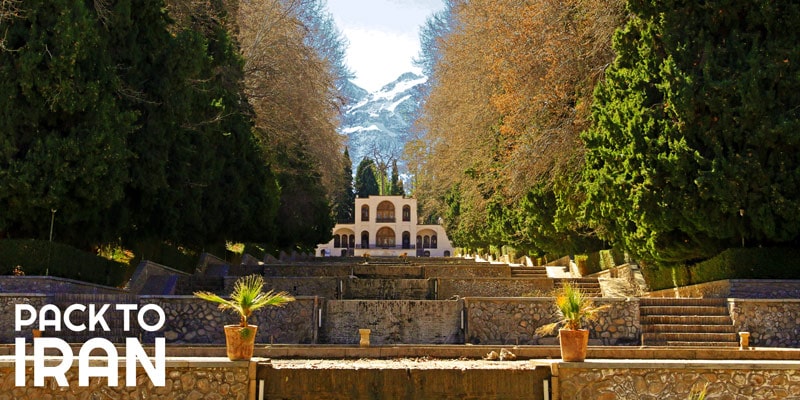The Persian Garden materializes the concept of Eden or Paradise on Earth. The word Paradise entered European languages from the Persian root word "Pardis", which was the name of a beautiful garden enclosed behind walls.
Persian gardens are constructed according to the layouts and patterns shown below:
|
|
|
Persian Garden patterns |
The history of Persian Garden:
Chahar Bagh, literally meaning “four gardens,” is a rectangular garden divided by paths or waterways into four symmetrical sections. Recent excavations at both Pasargadae and Susa suggest that the history of the Chahar Bagh begins during the Achaemenid period (550- 330 BC). The clearest evidence comes from Pasargadae (the ancient capital of Cyrus the Great), where the surviving elements of several stone water canals help to define the plan of a major garden, which was founded in the later years of the reign of Cyrus the Great (559-30 BC). Those stone channels describe the outline of two contiguous rectangular garden plots and the limits of a broad pathway that once enclosed the whole on at least three sides (Stronach, 1978, pp. 107-12).
During Sassanid period (3rd to 7th century) and under the influence of Zoroastrianism, gardens were designed in a way that the four quarters of the garden resembled four Zoroastrian elements of Fire, Earth, Water, and Air, and the importance of water running through the garden was more emphasized as the water was considered as a very holy element in Zoroastrianism.
During the Islamic period, more attention was paid to the aesthetic aspect of the gardens. According to the Islamic notion, the Persian garden resembled heaven described in Quran, the holy book. Being inspired by the image of heaven, Iranians put more emphasis on four heavenly streams running through the garden.
Persian Garden and Iranian arts:
The Persian Garden as an artifice has inspired other forms of art, particularly poetry, painting, carpet weaving, and the decorative arts. Garden settings appear frequently in Persian miniature paintings from the late 14th century. Many carpet designs are inspired by Persian garden and it is better to say that Persian carpets are flat Persian gardens with many trees, flowers, and birds.
|
|
|
| Antique Persian Garden Carpets |
What are 9 Persian Gardens that should be visited?
A collection of nine gardens were selected from various regions of Iran as a concept of Persian Garden designated by UNESCO as a World Heritage, which tangibly represents the diverse forms that this type of designed garden has assumed over the centuries and in different climatic conditions. These gardens, which are mentioned below are all UNESCO World Heritage sites and reflect the flexibility of the Chahar Bagh design:
-
The ancient Pasargadae Garden - Fars
Constructed in 6th century BC, the ancient Pasargadae Garden was the royal garden of Cyrus the Great and is located in the ancient Pasargadae city which was the first capital of the Achaemenid Empire. The remains of the water canals made of stone prove that this was a Persian Garden following the Chahar Bagh pattern. The ancient city of Pasargadae is located 120 kilometers away from Shiraz. Visit Pasargadae Garden on this tour!
|
|
| The ancient Pasargadae Garden - Fars |
|
|
| Pasargadae Garden - Fars |
-
Eram Garden - Shiraz
The gorgeous Eram Garden is located in the city of Shiraz. The word Eram refers to a part of heaven as mentioned in Quran holy book. It is said that the Eram garden was established during the Seljuk Dynasty, but its glorious pavilion was constructed during the Qajar Dynasty. Then this garden was the residence of the Qashqai tribe leaders for 75 years. With numerous plant species, today Eram Garden is a botanical garden observed by the Shiraz University. Visit Eram Garden on this tour!
|
|
| Eram Garden - Shiraz |
-
Chehel Sotoun Garden – Isfahan
Chehel Sotun Palace (literally meaning 40 columns) and its garden were constructed in Chahar Bagh Street of Isfahan, which was once a street full of Persian gardens, by the order of Shah Abbas in 1588. The superb Chehel Sotoun Palace, which is known for its great frescos and ornaments, was used for holding official gatherings. There is a pool in the garden which reflects the picture of the 20 columns of the pavilion and creates the illusion that there are 40 columns. Visit Chelel Sotoun Garden on this tour!
|
|
| Chehel Sotun Garden - Isfahan |
-
Fin Garden – Kashan
Being constructed in the late 16th century by the order of Shah Abbas I, the lush Fin Garden is located in Kashan city with a semi-arid climate. This traditional garden with its turquoise water canals and pools and aged trees are watered by the water of a spring near the garden. Amir Kabir, the chancellor of Iran during the Qajar Dynasty, was exiled to this garden and then got assassinated in the bathhouse of the garden by the order of Naser el-Din Shah. Visit Fin Garden on this tour!
|
|
| Fin Garden - Kashan |
-
Shazdeh Garden – Mahan
Mahan is a town near the historic city of Kerman and is home to the magnificent Shazdeh Garden, literally meaning the “prince’s garden”. The garden was built by the governor of Kerman in the 1890s and is known as a piece of emerald in the heart of the barrens. Shazdeh Garden has a stepped design and has a long central canal. Visit Shazdeh Garden on this tour!
|
|
| Shazdeh Garden - Mahan, Kerman |
-
Dowlat Abad Garden – Yazd
Being constructed in 1750, Dowlat Abad Garden of Yazd is another sample of the gardens located in desert cities. This garden is mostly known for its superb pavilion with colorful lattice windows and interior designs, and the loftiest badger in Iran which is 33.8 meters high. Visit Dowlat Abad Garden on this tour!
|
|
| Dowlat Abad Garden - Yazd |
-
Pahlavanpour Garden – Mehriz
This garden is located in Mehriz, a historic town near Yazd. Pahlavanpour Garden was built during the Zand Dynasty and belonged to Mr. Hasan Molla Reza and then his son in law Mr. Ali Pahlavan. This Persian garden is known for the water canals flowing under the trees, which come from an old Qanat named “Hasan Abad”. Today, the pavilion inside the garden is used as a traditional hotel.
|
|
| Pahlavanpour Garden - Mehriz, Yazd |
-
Akbariyeh Garden – Birjand
This beautiful garden with its wonderful mansion was constructed as a residence for the governor of Birjand, which is a city in Khorasan Province, during the Qajar Dynasty. The tall pine trees of Akbariyeh Garden are fed by Qanat water.
|
|
| Akbariyeh Garden - Birjand |
-
Abbasabad Garden - Behshahr
Built during the Safavid Dynasty, Abbasabad Garden is the only Persian garden which is located in the north of Iran, where the weather is rainy most of the year. This green garden is known for its artificial lake surrounded by forest trees and the Chahartaq (four arcs) building in the middle of the lake. Visit Abbasabad Garden on this tour!
|
|
|
Abbasabad Garden - Behshahr, Mazandaran |





.jpg)

.jpg)



.jpg)







